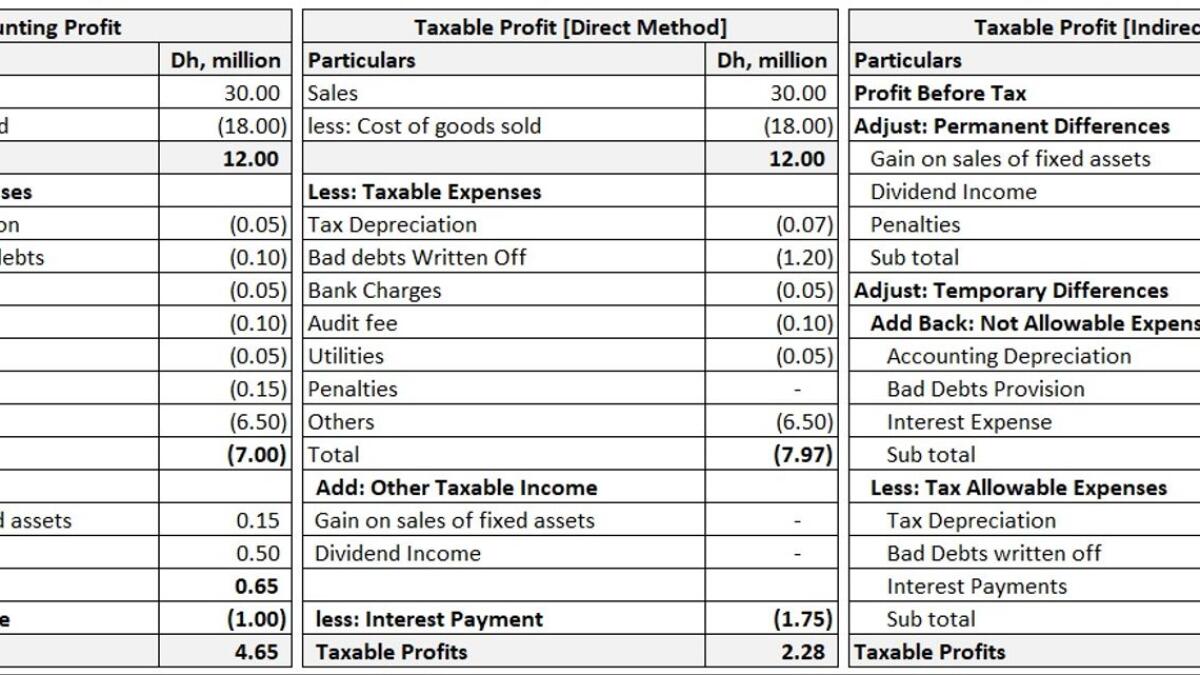
28 Feb
How to compute taxable profits in the UAE
Under the direct method of calculating taxable profits, we can calculate the taxable profits directly by deducting the cost of goods sold, tax allowable expenses and other allowable deductions from the gross income of the corporations
Our previous article focused on the differences between accounting and taxable profits. We established that permanent differences and temporary differences lead to differences in accounting profits and taxable profits. We concluded that permanent differences are incurred in one period and do not impact the subsequent period. In comparison, temporary differences are incurred in one period and affect the following period.
In this article, we will learn how to compute taxable profits. There are two approaches to calculate taxable profits, and I am naming them as (i) Direct method and (ii) Indirect method.
Under the direct method of calculating taxable profits, we can calculate the taxable profits directly by deducting the cost of goods sold, tax allowable expenses and other allowable deductions from the gross income of the corporations. Taxable income, if any would be added to arrive at the taxable profits. So, we can say that:
“Taxable Profits = Gross Income – Cost of goods sold – Tax allowable expenses and deductions + Other taxable income.”
This is a straightforward method of calculating taxable profits, and it would be very effective if the corporations were not preparing the financials regularly.
In the indirect method, taxable profit can be calculated by making accounting profits as a base, adding back all disallowable expenses, deducting tax allowable expenses, adding taxable other income, and deducting non-taxable other income. For example, the equation would be as under:
Add: Disallowable expensesXXXX
Less: Tax allowable expensesXXXX
Add: Other taxable incomeXXXX
Less: Other nontaxable income XXXX
Taxable ProfitsXXXX
Companies and tax authorities prefer to use the indirect method to calculate taxable income. This is a very effective and reliable method to compute the corporate tax where corporations are preparing the financials regularly, and these financial statements are audited by external auditors. In addition, it’s quick to calculate taxable profit as accounting profits is taken from the audited financials, and the break of other numbers is available in the notes to the financial statements.
In both of the above methods, tax allowable expenses and income are based on the principles and rules defined in the corporate tax law and related regulations.
Example: ABC company has an annual income of Dh 30 million, and its cost of goods sold is Dh18 million. The company’s operative expenses are Dh7 million which includes: Accounting depreciation of Dh0.05 million while tax depreciation is Dh0.07 million; Provision for doubtful debts of Dh0.1 million while actual debts of Dh1.2 million has been written off; Bank charges Dh0.05 million, Audit fee Dh0.10 million, Utilities Dh0.05 million; Penalties Dh0.15 million, and Other expenses Dh6.5 million. The company sold a machine, and the gain was Dh0.15 million. ABC earned a dividend income of Dh0.5 million. ABC Interest expense is Dh1 million, while the actual interest payment is 1.75 million.

Solution: The diagram shows that the accounting profit before tax is Dh4.65 million while taxable profit is Dh2.28 million under both methods. Therefore, tax payable would be Dh0.21 million [Dh2.28*9 per cent].
While calculating the taxable profits, tax depreciation and bad debts written off have been allowed for tax purposes instead of accounting depreciation and provision of doubtful debts, which are not allowed for tax purposes. Penalties have not been allowed for tax purposes as an expense. Interest expense has been disallowed, while interest payment has been allowed for tax purposes. Dividend income and capital gain (gain on sale of fixed assets) are not subject to tax, so it has not been considered taxable income.
Dividend income, gain on fixed-assets sales, and penalties have created permanent differences. This means these will impact the current period, and it will not have any impact in the subsequent period. Depreciation, bad debts provision and interest have created temporary differences, and it would be offset in the following period. Both administrations have accepted bank charges, audit fees, utilities and other expenses as allowable expenses.
The above understanding is based on the global practices and press releases issued by the Ministry of UAE on corporate tax. Once introduced by the UAE government, the law and related regulations would set a clear basis for corporate tax computation.
Source:https://www.khaleejtimes.com/finance/how-to-compute-taxable-profits-in-the-uae